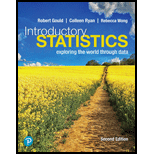
Concept explainers
Preventing Heart Attacks with Aspirin Suppose that you want to determine whether the use of one aspirin per day for people age 50 and older reduces the chance of heart attack. You have 200 people available for the study: 100 men and 100 women. You suspect that aspirin might affect men and women differently.
To ensure an appropriate comparison group, those who do not get aspirin should get a placebo.
a. Identify the treatment and response variables.
b. Describe in detail a simple randomized design (not blocked) to test whether aspirin lowers the risk of heart attack.
c. Describe a blocked design to test whether aspirin lowers the risk of heart attack; the blocking variable is gender.
d. Explain why researchers might prefer a blocked design.
Want to see the full answer?
Check out a sample textbook solution
Chapter 12 Solutions
Pearson eText Introductory Statistics: Exploring the World Through Data -- Instant Access (Pearson+)
Additional Math Textbook Solutions
Graphical Approach To College Algebra
Elementary Statistics ( 3rd International Edition ) Isbn:9781260092561
Calculus for Business, Economics, Life Sciences, and Social Sciences (14th Edition)
Precalculus
APPLIED STAT.IN BUS.+ECONOMICS
Thinking Mathematically (6th Edition)
- 6. Show that, for any random variable, X, and a > 0, Lo P(x -00 P(x < xarrow_forward5. Suppose that X is an integer valued random variable, and let mЄ N. Show that 8 11118 P(narrow_forward食食假 6. Show that I(AUB) = max{1{A}, I{B}} = I{A} + I{B} - I{A} I{B}; I(AB)= min{I{A}, I{B}} = I{A} I{B}; I{A A B} = I{A} + I{B}-21{A} I{B} = (I{A} - I{B})². -arrow_forward11. Suppose that the events (An, n ≥ 1) are independent. Show that the inclusion- exclusion formula reduces to P(UAL)-1-(1-P(Ak)). k=1 k=1arrow_forward8. Show that, if {Xn, n≥ 1} are independent random variables, then sup X,, A) < ∞ for some A.arrow_forward20. Define the o-field R2. Explain its relation to the o-field R.arrow_forward11. (a) Define the (mathematical and conceptual) definition of conditional probability P(A|B).arrow_forward12. (a) Explain tail events and the tail o-field. Give an example.arrow_forwardLet A, A1, A2,... be measurable sets. Then P(A)=1- P(A); • P(Ø) = 0; P(A1 UA2) ≤ P(A1) + P(A2); A1 C A2 P(A1) P(A2); P(UA) + P(n=14) = 1. Exercise 3.1 Prove these relations. ☐arrow_forwardarrow_back_iosSEE MORE QUESTIONSarrow_forward_iosRecommended textbooks for you
 Glencoe Algebra 1, Student Edition, 9780079039897...AlgebraISBN:9780079039897Author:CarterPublisher:McGraw Hill
Glencoe Algebra 1, Student Edition, 9780079039897...AlgebraISBN:9780079039897Author:CarterPublisher:McGraw Hill Holt Mcdougal Larson Pre-algebra: Student Edition...AlgebraISBN:9780547587776Author:HOLT MCDOUGALPublisher:HOLT MCDOUGAL
Holt Mcdougal Larson Pre-algebra: Student Edition...AlgebraISBN:9780547587776Author:HOLT MCDOUGALPublisher:HOLT MCDOUGAL Big Ideas Math A Bridge To Success Algebra 1: Stu...AlgebraISBN:9781680331141Author:HOUGHTON MIFFLIN HARCOURTPublisher:Houghton Mifflin Harcourt
Big Ideas Math A Bridge To Success Algebra 1: Stu...AlgebraISBN:9781680331141Author:HOUGHTON MIFFLIN HARCOURTPublisher:Houghton Mifflin Harcourt College Algebra (MindTap Course List)AlgebraISBN:9781305652231Author:R. David Gustafson, Jeff HughesPublisher:Cengage Learning
College Algebra (MindTap Course List)AlgebraISBN:9781305652231Author:R. David Gustafson, Jeff HughesPublisher:Cengage Learning
 Glencoe Algebra 1, Student Edition, 9780079039897...AlgebraISBN:9780079039897Author:CarterPublisher:McGraw Hill
Glencoe Algebra 1, Student Edition, 9780079039897...AlgebraISBN:9780079039897Author:CarterPublisher:McGraw Hill Holt Mcdougal Larson Pre-algebra: Student Edition...AlgebraISBN:9780547587776Author:HOLT MCDOUGALPublisher:HOLT MCDOUGAL
Holt Mcdougal Larson Pre-algebra: Student Edition...AlgebraISBN:9780547587776Author:HOLT MCDOUGALPublisher:HOLT MCDOUGAL Big Ideas Math A Bridge To Success Algebra 1: Stu...AlgebraISBN:9781680331141Author:HOUGHTON MIFFLIN HARCOURTPublisher:Houghton Mifflin Harcourt
Big Ideas Math A Bridge To Success Algebra 1: Stu...AlgebraISBN:9781680331141Author:HOUGHTON MIFFLIN HARCOURTPublisher:Houghton Mifflin Harcourt College Algebra (MindTap Course List)AlgebraISBN:9781305652231Author:R. David Gustafson, Jeff HughesPublisher:Cengage Learning
College Algebra (MindTap Course List)AlgebraISBN:9781305652231Author:R. David Gustafson, Jeff HughesPublisher:Cengage Learning